Leave it to Beijing (formerly called Peking), the oldest city in China, to house the largest palace complex on Earth. During the many centuries the Forbidden City remained the seat of royal government, it was, indeed, forbidden for all to enter, except for the reigning Chinese royalty, their servants, and occasional special guest.
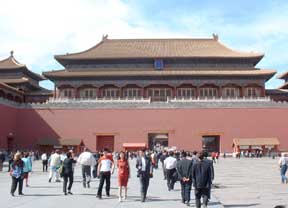
The size of the Forbidden City defies description. Even from the enormous courtyard entrance, shown in the first picture, it's impossible to gauge the scope of what's inside. Once inside, I repeatedly mused (while walking the length of yet another courtyard toward another palatial structure) that this surely must must be the final building before reaching the back wall. Every time (well, except the very last...) there would be another building revealed behind the one I'd just seen.
So as to keep with our theme of sweeping, the second photo shows the person doing cleanup out in the front courtyard.
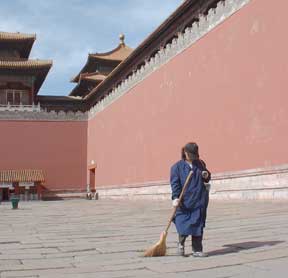
Built nearly 700 years ago, the entire complex is surrounded by a moat, and a 10-foot high wall completely encircles all the structures within. The City covers 72 hectares, which my computer's distance-converter claims is equal to 178 acres. I can assure you that, when you walk from one end of it to the other, it's a very long way. The north to south distance of the palace complex measures 960 meters, and it runs east to west 720 meters. During our visit, we were buffeted by (my estimate of 35+ mph) winds from an approaching squall, making it quite a chore to even remain upright as we walked.
Construction of the Forbidden City was begun in 1406 by a member of the Ming dynasty. I wondered if his plan was to build the palace quickly enough to be able to live in it in his lifetime -- or if the local economy was experiencing a recession and needed a jumpstart -- because I was told that he paid wages to a million workers. Allegedly, he also employed the services of 100,000 engineers and skilled technicians. I doubt that, today, even the Pope could get that many designers to agree on any design that would stand this long.
Perhaps the building project was so successful because the emperors of that era had complete life-and-death control over their subjects, or perhaps it was that the edifice was built before attorneys were invented. I am sure of at least one thing: The committee meetings would have been grueling! In 1420, a mere fourteen years after construction had begun, history tells us the Forbidden City was 'a wrap.'
One of the aspects I found particularly fascinating was the fractal-like artwork. The mathematical formations may be inspected at any magnification, and still remain beautiful. An example can be seen in this photo of the roof of one of the porches.
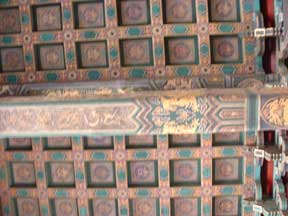
Shown is just a small area next to one of the 18 beams that spans the porch. The detail work is incredible, and goes on and on and on. Everywhere one looks, from floor tiles to walls to ceilings, is carved and filigreed in the finest detail.
The palace was actually in use during a total reign of 24 emperors, through the Ming and Qing dynasties. Each of the palace structures was intended for a particular usage. Yu (our interpreter and guide), informed us that during those years, the males and females didn't mingle much. The emperor was in complete control, of course, and he had a number of buildings to 'hang out' in, each with a specific usage. One building was used solely for entertaining and holding audiences with visiting potentates and invited dignitaries from other lands. Another was his office, though he had another office in his bedroom building, as well.
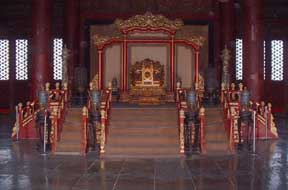
Of course, like all great palaces, virtually all the buildings in the Forbidden City had an ornate throne from which the current reigning emperor could greet visitors and dispense wisdom to petitioners. On the larger throne, located in the Hall of Great Ceremony, is a signed that reads: "The Hall of Great Harmony, popularly called Jin Luan (Hall of Imperial Throne), was first built in 1420. The present hall was rebuilt during the reign of the Qing emperor, Kangxi. It is 35.05 meters high and covers 2,377 square meters. Here, the Ming and Qing emperors held important ceremonies to mark accessions, birthdays, the lunar new year, the winter solstice, or the publication of the list of successful candidates in the Imperial Examination."
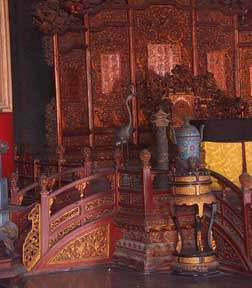
One of the enormous buildings was for the emperor's family and their servants, while another good-sized structure was reserved for his concubines. His servants would apparently direct traffic so the ladies of each 'station' in life wouldn't encounter each other coming and going.
Apparently, the emperor was free to do whatever he wanted; however, the other members of the family weren't nearly so fortunate. Yu told us that the children, especially, were completely cut off from the rest of the world. They had to be protected at all costs, so the easiest way to do that was to bring in any needed teachers or instructors, and keep them behind the walls. At the back wall, and at several other strategic points, were areas for them to sit and look out at what was happening outside the palace.
According to records, there were a total of 308 bronze and iron vats in the Forbidden City. A total of 18 gilted bronze vats were placed in front of Tai He Dian (Hall of Great Harmony), Bao He Dian (Hall of Preserving Harmony) and Qian Qing Men (Gate of Heavenly Purity), three of the huge buildings in the City. These vats were for putting out the frequent fires that were a matter of constant concern inside the wall. The bronze vats were filled with water, then covered with lids. In times of freezing weather, fires were lit under them to keep the water from turning to ice. Many other vats were used for food preparation. This must have been a daunting everyday task, let alone the added work on festival days and when royalty and their typically large entourages were visiting. These were not small cooking pots that might fit onto a normal stove.
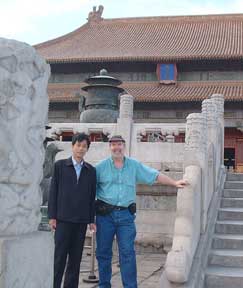
In the picture at right, I'm standing with Yu, our guide and translator.
Enduring artwork -- mostly cast bronze statues and carved stone -- is scattered throughout the grounds. Below you see a bronze bird standing about 4 feet in height.
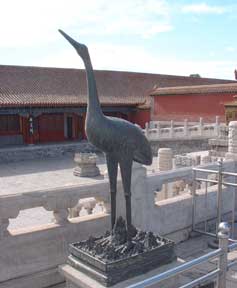
In the rear of the City is a large and ornate garden, with a number of bonzai-type trees, many well cared for flower beds, and a host of trees that are tagged with brass plates designating them as historical sites. In this area there is also the 'personal temple' that I'm standing in front of in the last photo. Included in this area was a manmade carved mountain measuring about 30 feet in both height and width. All in all, the Forbidden City was a spectacular place to visit, and one I'll long remember.
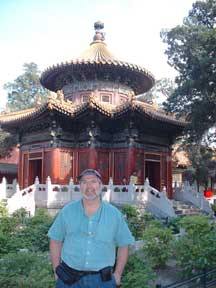
As I was leaving, I was looking forward to a quiet evening to recuperate from the day-long tour to the Jade Factory, the Great Wall, and the Forbidden City. This welcome break would allow me to catch up on my notes, and perhaps get some needed sleep. The next morning I was scheduled to meet Mr. Sun, one of the Beijing area's most well known personalities involved with sweeping.
However, upon my return to my hotel room I learned that Sun was in town a day early, and I'd been invited to eat with him that evening at one of the most incredible restaurants one can imagine -- the home of the first entree in Chinese history to be awarded a patent -- Beijing's famous "The Pig Face."



